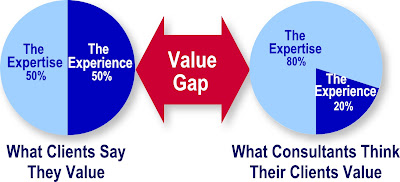 The "branded client experience" is consistent and intentional. This requires standards, process, and managed effort. I outlined one proven approach in my last post. The branded experience is also viewed as distinct and valued by the client. The only way to know what the client is thinking is to ask.
The "branded client experience" is consistent and intentional. This requires standards, process, and managed effort. I outlined one proven approach in my last post. The branded experience is also viewed as distinct and valued by the client. The only way to know what the client is thinking is to ask.That's simple, but often ignored, advice. Most A/E firms don't regularly solicit feedback from their clients. I presume they believe they either (1) don't need to or (2) don't care to know. Of course, no one would ever admit to not caring what the client thinks. Yet surveys indicate that clients often feel like their A/E providers don't really care. In fact, PSMJ reports that two-thirds of clients who defect do so because of perceived indifference.
Client surveys also debunk the notion that we can safely assume we understand what our clients want without specifically asking. In conducting such surveys myself, as well as facilitating several "partnering" sessions, I can testify that there are commonly problems about which the A/E firm is unaware. In my mind, no firm will succeed in providing consistently great service (experiences) without a regular program of seeking client feedback.
A critical first step in understanding client expectations comes at project outset, in a process I call "service benchmarking." This involves asking the client specific questions about how you can optimize the working relationship and deliver a great experience. From this information, you define what actions are needed to meet client expectations. Then you need to periodically ask, "How are we doing? What can we do better?"
There are two primary means of collecting feedback from your clients that I suggest:
Ongoing dialogue with the client. This should be your primary method for getting feedback. It involves regular conversations with the client at intervals mutually determined during the benchmarking step, plus a final debriefing at the end of the project or major project phase. This activity is best handled by someone other than the project manager, typically the principal in charge or other senior manager. This person assumes the role of Client Advocate (see below).
Formal client survey. A standardized questionnaire is used primarily for tracking service performance trends across the company. While this is highly recommended, you should not use the formal survey as the primary means of gathering client-specific feedback. It's too impersonal for that purpose (although the Client Advocate can personally administer the survey, which makes it more personal and responsive).
The Client Advocate's Role
Many firms assume that their PMs can adequately monitor client satisfaction. But even the most diligent PMs can be sorely mistaken about their client's perception of their performance. Clients are often reluctant to voice their unhappiness to the PM, especially if the PM is perceived to be part of the problem.
That's why I advocate assigning to every key client relationship a Client Advocate. Preferably this is someone who is not directly involved in the project work (except potentially in an advisory or oversight role). Otherwise they lose some of the objectivity and independence needed to function effectively as Client Advocate. This person's responsibilities include:
Monitors client satisfaction. Keeps in touch with the client from time to time (as mutually agreed upon), checking to see that the client remains fully satisfied with the firm's performance.
Ensures responsiveness. Acts as an in-house advocate for the client, seeing that the firm is fully responsive to client needs and expectations.
Acts as third-party liaison. Serves as he point of contact when the client has a problem or concern that he or she prefers not to discuss with the PM, isn't getting an adequate response from the PM.
Conducts the periodic formal survey. Administers the formal survey and follows up to see that the firm responds to client concerns or suggestions that are uncovered in the survey.
The Formal Survey
Following are some suggestions for maximizing the success of the formal survey as part of your process for gathering client feedback:
Define appropriate interval. Either annually or biannually is recommended. The proper frequency will be guided in part by the nature of both the project and your relationship with the client.
Solicit the client's involvement in advance. Explain the purpose of the survey, its value to both parties, and the minimal time involved on the client's part. For long-term clients, request their ongoing participation.
Distribute the questionnaire electronically. Doing the survey in person or over the phone obviously has advantages. But I'm assuming your Client Advocate has already been talking to the client. The formal survey serves a different purpose and is more easily distributed by email—either as an attachment or with a link to a secure web site (SurveyMonkey.com is an excellent resource). Filling out the survey should be hassle free, requiring no more than about 10 minutes of the client's time.
Contact non-responders. Request responses within a week, then have the Client Advocate call or email to ask if the client received the survey (a not-so-subtle but friendly reminder). This will significantly improve your response rate. Remember, you've already had the client agree to participate.
Address problems promptly. When client concerns or complaints are uncovered (and undoubtedly this will happen from time to time), you need to respond promptly and appropriately. In fact, you should define the process for addressing client concerns before sending out the survey.
Share the results with your clients. A great way to demonstrate your commitment to great client service is to send a summary of the survey results to those clients who participated. Include in that summary the actions your firm plans to take to improve service.
For a questionnaire to use for this purpose, check out this one on my website. I developed it jointly with PSMJ and have used it with good results for several years.
How to Get Started
This best feedback will come from clients who are: (1) convinced that your firm is indeed committed to client service improvement and (2) are willing to actively help your firm improve. These are clients who recognize the value of a strong working relationship and are willing to invest a little of their time in making it happen. Don't expect all your clients to participate. But take steps to engage those who will.
Start with your best clients. The best way to generate momentum for this process is to start with those clients who have a mutual interest in strengthening the working relationship. Pick an easily manageable number of clients to start, where you're confident you can be fully responsive to whatever feedback you receive. Then expand to other clients when you're ready.
Build accountability into the process. Make sure your Client Advocates are fulfilling their roles, keeping in touch with the client, promptly responding to any client concerns, and seeing that the project team is meeting expectations. Anything less and the process will quickly lose credibility with both your clients and your employees.
Communicate client feedback to your staff. Everyone in your firm should be engaged in continually improving service and striving to deliver the branded experience. Feedback from clients is the fuel that keeps the fires of continuous improvement burning. Give all employees a stake in helping your firm become a service leader. Share feedback, lessons learned, and success stories.






